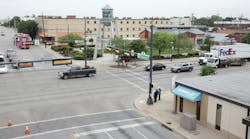10 Years Ago
In his article “The Evolution of Pushbutton Locks,” Jerry Levine wrote, “Looking into the future, the pushbutton lock will continue to provide key free access for both mechanical and electronic entry and utility lock applications.” While that’s still true today, the trend has shifted towards locks that can be operated touchlessly and via smartphone apps. Another June 2013 article described the Schlage Touchscreen Deadbolt and Nexia Home Automation as the wave of the future. Fire door inspections were recommended as a profit center for locksmiths, and Tim O’Leary outlined the training required to become a certified fire door inspector. O’Leary also offered tips for conducting an effective site survey. Allegion’s Lori Greene explained code requirements for stairway doors and dispelled some common myths about this often-misunderstood topic. ASSA ABLOY launched its Security Professionals Showroom, which still makes the rounds at industry events. Joseph Vaida, Ingersoll Rand (now Allegion), wrote a Problem Solver column titled "Selecting the Right Door Hardware for the Application."
20 Years Ago
Kaba Mas safe deposit locks were the subject of an article by Jerry Levine. Pro-Lok safes which use electronic locks were featured. Hugh Curry reported on Net Changer, a cash handler safe by Corporate Safe Specialists. Shelomo Barkan showed the merits of his ISM high-security safe line. Locksmith Mike Foty took on the job of opening a Blue Diamond safe which was equipped with an outdated Bell sidewinder cam lock. IR explained their LockLink Express software which manages electronic access platforms. Tom Gillespie wrote an informative article on the basics of interchangeable core cylinders. Rod Oden explained the outcome after the Best Lock Corp. vs. Ilco Unican lawsuit in 1996. A chart listed key blanks and code series used by large trucks. Jerry Levine installed a Kwikset Ultramax pocket door lock. Tim O’Leary checked out the AC-Q44 access control system by Rosslare. Gale Johnson reported on the heavy duty Bianchi 104 key duplicator. Steve Kaufman interviewed Bill Neff, still a successful locksmith today in Lancaster, Penn.
Solving Commercial Door Problems
Commercial doors range from high-end decorative entry doors equipped with automatic door operators to alley or loading dock doors that get opened using a cart, fork lift or pallet jack. In addition to the doors, the condition of the building is a significant factor in the operational life and a good indicator of the problems that may occur. By building condition, we are referring to its structural integrality in regards to the door openings. They should be plumb, with solid jambs and doors that swing open and closed and latch without external resistance.
The placement of exterior doors plays a significant role in potential problems. For example, take an exterior hollow metal door located on the east facing side of a poured concrete building. There was no awning or cover structure over this door because it was a secondary entrance. To make matters worse, the slab-sided building and the door were painted a dark color that absorbs heat. At peak summer temperatures, the hollow metal door became so hot that it warped. Over time, the heat warpage had a residual affect and the door became permanently bowed along the lock edge. The door had to be replaced as people could no longer either open or close the door.
Door warpage as a result of heat is basically limited to hollow metal doors. In many instances, if the door becomes warped, it may return somewhat to shape when pressure is no longer exerted or when the temperature cools off. However, most warped door will stay warped or get worse.
Note: In the early stages of warping, you must check for this problem during the hottest part of the day.
Door manufacturers offer doors that are designed to resist warpage. As an example, Steelcraft B-Series flush doors have steel stiffened core construction with welded 22 gauge hat section stiffeners and epoxy filled mechanical interlock edges provide structural support.
Other considerations included traffic flow, pivots and hinges, and the most common complaint from the customer, failure to close.
Here is a relatively short list "door not closing" problems:
- Weather strip
- Door hardware and lock mechanisms damaged
- Hinges no longer secured to the jamb or door
- Hinges incorrect, worn, abused or improperly "adjusted"
- Building settling
- Jamb no longer plumb
- Latch not entering strike plate
- Door closer out of adjustment/ not operable
- Door operator out of adjustment/not operable
- Door warps or warped
- Door damaged
Read full article at www.locksmithledger.com/10938125






